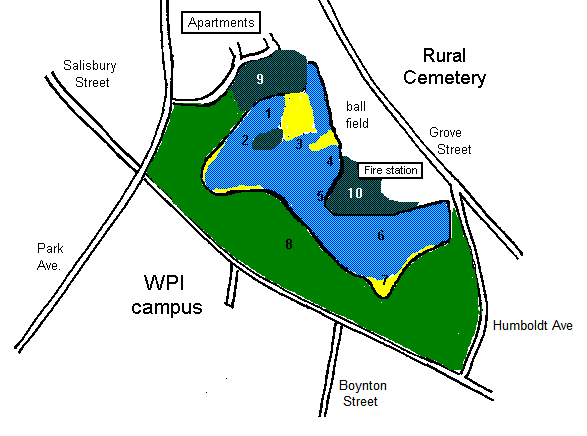Birding Map of Institute Park

BLUE GREEN YELLOW GRAY
open open lawn cattail Forest
water with scattered marsh
trees
Key to Numbered Areas:
- Secluded bay surrounded by forest, marsh, and island, it harbors herons
(Green Heron, Black-crowned Night-heron, Great Blue Heron)
and ducks (Wood Duck) that are shy of humans.
- Mallard ducks are often found resting on the island here, and come to
the lawn near the apartments when someone shows up with bread (but please
don't feed the ducks!). Wood Duck occasionally seen here.
- Great Blue Herons are often seen along the marsh edge near the channel
here, and various ducks stay back in the channel (especially in winter,
when this area is often the only part of the pond not frozen).
- During migration, the shy ducks tend to hang out here, as far away from
people as possible. During summer, herons wait for fish along the shore,
and some small shorebirds (Spotted Sandpiper) are sometimes found.
- Mallards and other ducks sometimes rest on this point.
- This is the deepest part of the pond (about 2 meters), and some
migratory ducks prefer this (Ring-necked Ducks). This is where a Common
Loon made a very rare appearance in the fall of 1996.
- This cattail marsh often harbors Red-winged Blackbirds, herons, and
ducks (mostly Mallards). Song Sparrows often seen during migration.
- In the trees and on the lawn of the main part of the park, you can
often find land birds such as Starlings, Northern Flickers, Pine Warblers,
Chipping Sparrows, and occasionally a Red-tailed Hawk perched in a tree
eating a squirrel!
- The woods between the apartments and the bay is most rewarding in the
spring, when you can find a number of migrant warblers. Many of the land
birds on the checklist have only been seen in this area of the park.
- The woods around the fire station point may harbor migrant land birds
in season, although I haven't spent much time here.

